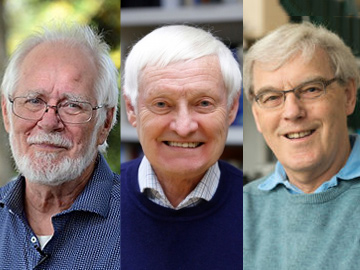
Jacques Dubochet, Joachim Frank, and Richard Henderson. [Images: Université de Lausanne/Columbia University/MRC Laboratory of Molecular Biology]
The 2017 Nobel Prize in Chemistry has gone to three scientists who laid the groundwork for cryo-electron microscopy (cryo-EM), a method of imaging biomolecules that, in detail and flexibility, far surpasses the workhorse technology for determining protein structures, X-ray crystallography. The three new chemistry laureates—Jacques Dubochet of the Université de Lausanne, Switzerland; Joachim Frank of Columbia University, USA; and Richard Henderson of the MRC Laboratory of Molecular Biology, U.K.—were honored “for developing cryo-electron microscopy for the high-resolution structure determination of biomolecules in solution.”
The problem with crystals
Over the past half century, the field of structural biology—the determination of the structure of proteins and other biomolecules, and how it relates to function—has relied on studies of proteins crystallized from solution and then examined using techniques such as X-ray or electron crystallography. While those techniques have resulted in a massive library of protein structures that form a pillar of molecular biology, they have some problems.
Some proteins are extremely difficult to crystallize, for example. And even when crystallized, they form only a snapshot of the molecules in time, as biomolecules in the wild exist in aqueous solution and can be highly dynamic in structure and function.
A better solution would be to image the molecules directly in their native habitat. But the best technology for bringing back such an image at atomic resolution—electron microscopy—would destroy the biomolecules except at very low doses, and in any event only works in a vacuum. Moreover, the drift of biomolecules in an aqueous solution would present huge challenges in obtaining a usable image.
Flash-frozen samples
The three 2017 chemistry laureates solved this problem in work beginning in the early 1980s, by developing and building on techniques that essentially flash-freeze aqueous solutions of micromolecules into a form that can be investigated by the electron microscope. In essence, biomolecule-containing solutions are cooled extremely rapidly into an amorphous state—“vitrified water”—that suspends the biomolecules in place. And cooling the sample has an extra benefit: it increases the molecules’ resistance to radiation damage, setting them up for investigation using the electron microscope.
The key findings that kicked off the field came from Jacques Dubochet and his coworkers, who in the early to late 1980s developed methods for creating thin layers of vitrified water that could be used in electron microscopy. Richard Henderson’s lab followed up in 1990 with the first high-resolution structures that used cryo-EM, creating detailed atom-level structures of the protein bacteriorhodopsin by averaging images of millions of molecule copies in a single crystal.
Sorting images
The third laureate, Joachim Frank, made a complementary contribution that helped make the approach practical for studying ensembles of biomolecules—which tend to be asymmetrical and, in any given sample, are randomly oriented, making it hard to obtain a 3-D structure. In work beginning in the mid-1970s, Frank and colleagues developed mathematical techniques that allowed images to be sorted into classes based on their orientation and structural features, particularly as read out in the projections of the molecules on the imaging substrate.
The technique—which relies on calculations of pixel intensity and cluster analysis—was amenable to computerization, and indeed Frank has wrapped it into a widely used computer-software suite called SPIDER.
Molecular movies
Taken together, the results honored by the 2017 Nobel Chemistry prize promise dramatically improved views of how biomolecules actually behave “in the wild”—not only by creating sharp, high-resolution images of non-crystalline structures, but through the ability to capture many such images at one time. The Nobel chemistry committee highlighted the ability to pull data from the method together into “molecular movies” that can shed light on the dynamics of protein folding and activity.
The chemistry committee cited in particular the method’s success in recently illuminating the structure of the Zika virus. And the committee added that recent technical developments in CMOS-based sensors and CCDs to allow direct detection of electrons could ratchet up the technique’s signal-to-noise ratio and the speed of data throughput.
Reached by telephone during the prize announcement, Frank—asked the predictable question about the work’s “immediate practical use”—noted that often the implications of fundamental research aren’t felt in the medical clinic for years, yet they can have an immense impact. “X-ray crystallography, during the past five decades, has resulted in 100,000 structures that are all publicly available, and they now form the basis of molecular medicine,” he said. “The same transformation will happen with … cryo-electron microscopy.”
More fodder for Nobel critics?
With the selection of the chemistry laureates, the Swedish Academy of Sciences has now named the recipients of all three of the “hard science” Nobel Prizes for 2017. And the specific choices are likely to provide further grist for those who criticize the Academy for being insufficiently inclusive in its selection process.
In an interesting exchange after the main prize announcement, a journalist from China noted that seven out of the nine prize recipients this year are from institutions in the United States, and asked Göran Hansson, the secretary general of the Academy, why other societies have been less represented. Hansson’s answer pointed to the support—including financial support—of basic, curiosity-driven research in the United States since World War II, though he was also at pains to stress that these conditions “are not unique to the United States.” He also cited the difficulty that other societies have historically had, in situations such as economic disadvantage and colonialism, in “mobilizing enough resources for science.”
The prizes have also been criticized for heavily favoring male recipients, and the nine 2017 science laureates are indeed exclusively male (and white). Before the announcements, there was widespread speculation that one of the prizes might go to the discovery of the CRISPR gene-editing technique, which likely would have awarded the prize to several women. However, CRISPR is currently the subject of a rather acrimonious patent dispute between two universities, and the Nobel committees may not have wanted to wade into that particular swamp.
